
An innovative approach to upgrading the energy performance of multifamily housing first promoted by the Dutch government a decade ago, has taken its first, tentative steps into the U.S. affordable housing market.
In New York City, the RiseBoro Community Partnership is rehabilitating nine apartment buildings it owns in the Bushwick neighborhood of Brooklyn in a project called Casa Pasiva. The $20 million overhaul will bring the apartments up to Passive House standards and sharply reduce their energy consumption and carbon emissions.
Patterned after the “Energiesprong” retrofits developed in the Netherlands, the upgrades will give the apartment buildings new facades up to 8 inches thick that contain insulation, heating and cooling lines, and fresh air ducts. Most of the energy-related work takes place on the outside of the building. Separately, similar efforts also are underway in California and Boston, although the construction of prototypes is still some months away.
A total of 146 apartments will get the upgrades in Brooklyn, according to an article about the Brooklyn project in The New York Times. Existing steam radiators will be removed, and the apartments will get new induction ranges as well as fresh air via a roof-mounted energy recovery ventilator. Energy costs in the nine buildings are expected to drop by 80%, saving RiseBoro a total of $180,000 a year.
The price tag—which averages out to about $137,000 per apartment—also covers the cost of major capital improvements, such as new flooring, and renovated bathrooms and kitchens, and is not limited to energy upgrades alone, Ryan Cassidy, RiseBoro’s director of sustainability, said in a telephone call.
The project is part of a larger effort to reduce carbon emissions in New York State by 85% by 2050. Under New York City’s Climate Mobilization Act, the owners of some 50,000 buildings will be required to cut carbon emissions by 2024 or face fines.
Project comes in two phases
Casa Pasiva was designed by the New York architect Chris Benedict, an expert on high-performance multifamily projects. Cassidy said RiseBoro had worked with Benedict in the past, most recently on two new Passive House projects, in 2013 and 2014. “We had a long relationship,” he said, “and we knew the text step in Passive House design were these retrofit buildings.”
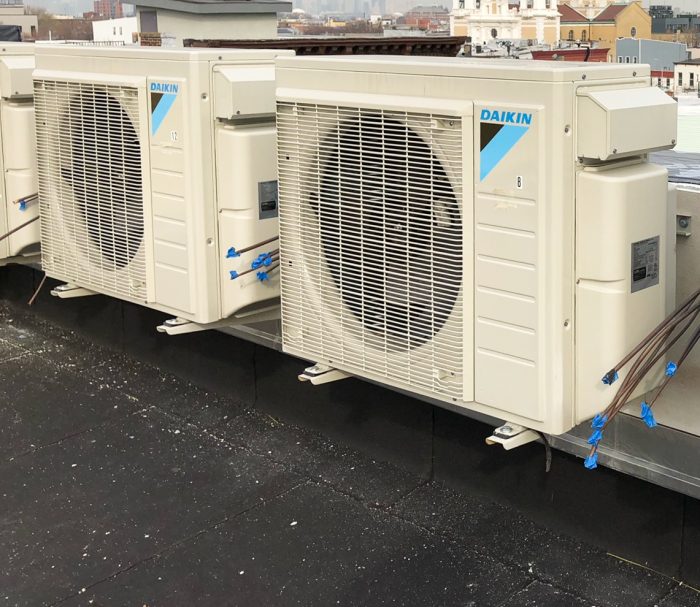
The project, which has been pre-certified by Passive House Institute U.S., is divided into two phases—a group of five pre-war masonry structures and another group of four, newer concrete buildings.
Work started about a year and a half ago after a lengthy design phase. About 90% of the units in the first phase are finished, with the end of Phase 2 some six to 10 months out.
The three- and four-story walkups are among the 150 buildings and 2000 rental units that RiseBoro owns and manages in New York City.
Europe has been a model for change
Energiesprong is the backdrop for Casa Pasiva, but the upgrades currently underway in Brooklyn are using an “external insulation finishing system” (EIFS) rather than prefabricated panels that are at the heart of the Dutch program. Cassidy hopes it is the first step in developing a retrofit model more like the Dutch original in the future.
As originally announced, the European project called Transition Zero was intended to upgrade 110,000 public housing units in the Netherlands to net-zero status. The idea was that payments on loans to pay for the work—the equivalent of about $51,000 per unit—would be covered by lower heating bills. Residents would pay no more to live in a net-zero home than they had been paying previously.
The Energiesprong (which means “Energy Leap”) approach is fast and effective. New building facades are assembled with the help of precise 3-D scanning that records dimensions of existing features, with enough flexibility in the system to account for variations in individual buildings. Trucked to the site, prefabricated panels that include windows, doors, and mechanical systems are craned into place and bolted to the existing exterior.
The upgrade takes about a week, with residents able to stay in place during most of it. The Dutch retrofits also included solar panels. Since the program’s launch in 2010 with a €40 million grant from the Dutch government, Energiesprong has spread to several other European countries.
A group called REALIZE is now working on an Energiesprong-like campaign tailored for the U.S. It is drawing on the talents of the Rocky Mountain Institute, the Passive House Institute U.S., and the Net-Zero Energy Coalition (now called Team Zero). With the help of a $500,000 grant from the U.S. Department of Energy the group got to work on developing a prototype in late 2017.
At the RMI website, the group describes its approach this way: “REALIZE is combining demand aggregation, using a ‘zero over time’ approach, and supply chain coordination to deploy high-quality, prefabricated mass-scale retrofit packages that are easy to install and are financed through utility cost savings. Our vision is a future where buildings are heated, cooled, and powered using renewable, non-greenhouse gas emitting resources and where historically disenfranchised communities are fully included in the benefits and can take part in the new workforce it will take to get there.”
There are projects underway in both California and Boston, with a pilot project heading for construction later this year.
At the same time that REALIZE was getting up to speed, the New York State Energy Research and Development Authority launched a building program called RetrofitNY with similar aims. It was to be bankrolled by $30 million over 10 years, with the goal of developing the technology to retrofit the state’s affordable housing stock for significantly better energy performance.
Casa Pasiva was able to tap into this fund, pulling down $1.8 million in financing. The nonprofit advocacy group Urban Green Council estimates that it could cost $20 billion to bring all buildings in New York into compliance with the Climate Mobilization Act, according to The Times. That effort could mean not only the development of new rehab technologies but also 141,000 jobs.
Too soon for prefab facades in New York
Apartment buildings selected for Casa Pasiva represent two common types of multifamily buildings in the city, so they were a good place to begin developing Passive House overhauls, Cassidy said. “We knew that if we could succeed in doing a deep energy retrofit we knew it would be replicable for the rest of the city,” he said. “That was interesting to us as well.”
But for now, it’s too soon to copy the Dutch model. Although this “tilt-up” model employing prefabricated components was considered, Cassidy said, RiseBoro recognized the logistical problems of working in the narrow confines of New York City streets, and didn’t think the technology had matured enough here to be used.
“Even today there’s not really a proven tilt up model that would work in New York City,” he said “There’s a bunch of companies pushing for it and trying to get that off the ground, but I’m not sure we’ve seen it. The best is yet to come with that technology.”
Instead, building exteriors will be finished with an EIFS design developed by Sto called StoTherm ci Lotusan. After air sealing the masonry exterior of the buildings, the walls will be insulated and capped with a self-cleaning finish. Heat pumps and fresh air ducts will be contained in the walls. Insulation ranges up to 8 inches thick.
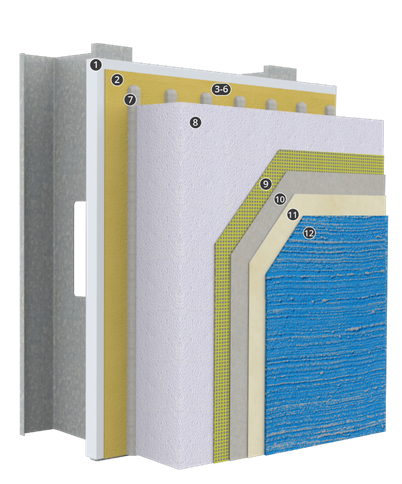
“What’s unique about this project is that we took all the HVAC components and pulled them to the outside of the building,” Cassidy said. That reduces the amount of time that workers have to be inside the apartments. Existing exhaust shafts for kitchen and bathroom vents will remain, but new fresh air supply ducts will be part of the exterior wall system. Units will be mostly electric after the work is complete. A gas-fired condensing boiler will be used for domestic hot water for the time being, mainly because natural gas is some 80% cheaper than electricity in New York City. But wiring for an eventual switch to a heat-pump water heater will be included in the current round of work.
The other piece of the project that Cassidy is excited about is a tandem research effort by a group at the Massachusetts Institute of Technology that will measure changes in air quality as the units switch to heat pumps for heating and cooling and junk gas kitchen ranges in favor of electric induction ranges.
The MIT group installed proprietary air sensors in the Phase 2 buildings and now have about a year of pre-construction data on indoor air quality. Cassidy called the air quality reports “a little scary,” noting that air quality drops off sharply after tenants have been cooking over the gas ranges for any length of time. Once the apartments have been renovated, and new ventilation equipment has been installed, scientists will be able to measure the difference in air quality that the conversions have made possible.
The Dutch Energiesprong approach is an appealing goal, even if it’s not possible right how, Cassidy said. Most of the developer’s projects these days are Passive House, and there are another 2000 housing units in the pipeline over the next five to seven years. On the near horizon are 300 or so new units in the next couple of years that will be following the Casa Pasiva model.
“I love the Dutch model, and I think it’s probably the long-term solution but we’re not doing it here,” Cassidy said. “Hopefully this is a good example of how to bridge until we get to that scalable Dutch model.”
In California, wall panels in development
The pilot REALIZE program underway in California involves five pilot demonstration sites in economically and environmentally disadvantaged communities—in San Jose, East Palo Alto, Los Angeles, Bakersfield and Fresno. These are not masonry buildings like the Casa Pasiva project in New York, but stick-framed buildings between one and three stories high, said Amy Egerter, a manager with RMI.
“Very quickly we learned on the technical side that the kinds of products that were used in the Netherlands—the wall panels with doors and windows pre-integrated, with the HVAC pod that does space heating and hot water and ventilation—those products did not exist in the U.S. Period,” she said in a telephone call. “A lot of what we’ve been doing is trying to figure out how to move existing manufacturers to develop those products.”
The group is working with Dryvit on a panelized, non-structural EIFS product. But because of the type of buildings that are commonly found in California, the panels will have to weigh no more than 4 lb. per square foot, which is one-half to one-third as much as the prefabricated panels used in the Netherlands. The aim is not to have to cut into or modify the panels after they are delivered to the job site.
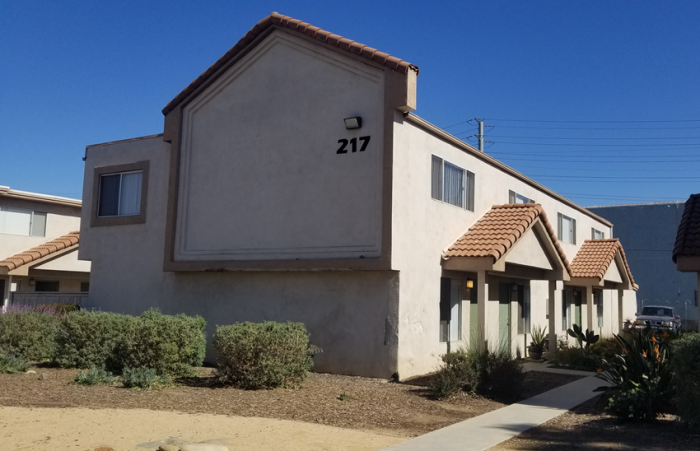
The lightweight, non-structural panels will not arrive on site with doors and windows installed. “We are, however, designing window buck connections that can be installed into the panel so that the onside labor to replace windows is shorter and more streamlined,” Egerter said in an email. The goal is for wall panels to have R-16 insulation values, with overall building tightness at between 1 and 2 ach50.
Egerter hopes the project can move into the construction phase at a demonstration site in Riverside sometime this summer. The two buildings are two stories tall, each with four unites. By the end of the year, they hope to have at least one of the buildings complete, making the program the first on the West Coast to use what she called a “prefabricated over-cladding approach.”
Financing remains a sticking point. Egerter had hoped that energy savings alone might pay for the renovations, as is the case with the Dutch Energiesprong program, but it’s not shaping up that way. Energy savings alone won’t be enough to cover what first costs are likely to be. The hope now is that one of the retrofit options that REALIZE is developing can be tacked onto a capital improvement project that is already scheduled. The 30-year present value of the energy savings would equal the incremental cost of the REALIZE package.
“Unfortunately,” she said, “emerging technology is not cheap.”
Boston’s project in development
The REALIZE pilot in Boston involves a seven-story masonry building, Brett Webster, a senior associate at RMI who is managing the project there, said in a telephone call. A Building America grant, will pay for design work but construction funds hinge on winning approval for a tax credit through the U.S. Department of Housing and Urban Development. That’s still in the works, so actual construction is not likely until the end of 2021 or early next year.
There are two possible approaches to the wall panels. One is an insulated metal panel that would include door and windows and be installed like a curtain wall rather than supported directly by the building’s existing facade. The other option is a type of structural insulated panel with a cementitious skin that could be attached to the building with an air gap separating the SIP and the existing wall. The decision on which option to pursue could be made within a month.
Work will be carried out on a 53-unit, seven-story building originally constructed in 1967, with the goal of retrofitting walls to R-33 and the roof to R-41. Heating, cooling and ventilation will be provided by rooftop equipment, with an ERV and a fan coil unit housed in an in-unit mechanical pod, according to an article about the project published in Passive House Buildings last year. The energy use intensity is projected to fall by 77%.
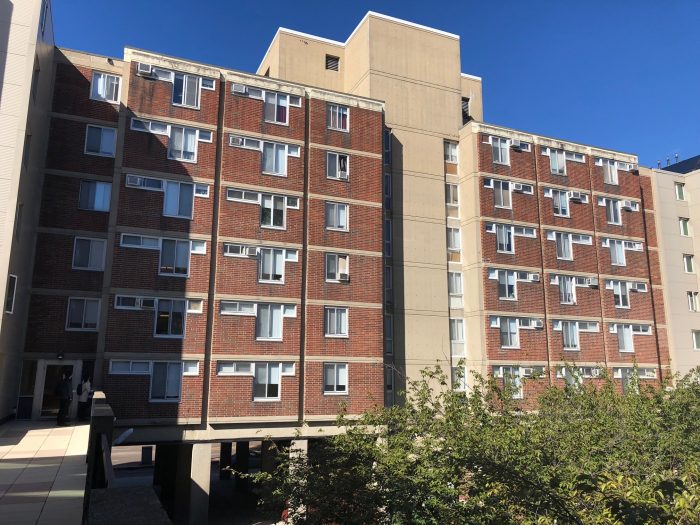
Asked whether it has been difficult to find manufacturers who might be interested in developing the kinds of panels needed for these retrofits, Webster said:
“We’ve had a fair bit of trouble with that, yes. I’d say there is increasing interest from manufacturers, so even in the course of the last six months we’ve had a lot more outreach and engagement with manufacturers than we’ve had in the previous six months, so it does seem like the motivation is picking up on the manufacturers side.
“But,” he added, “a lot of these products are still early stage, especially for the unitized type panels where windows and doors are preinstalled. It’s not a very well established market. There are both the technical challenges of figuring out exactly how to do it, and the cost challenges of how to manufacture these things at a price that could make a retrofit deal pencil.”
It will be difficult to develop an exact clone of the Dutch style Energiesprong program in the U.S. There, thousands of buildings have been upgraded, but housing stock in the U.S. is far more diverse, and so are the demands of climate, which affects choices on insulation, windows and doors, and HVAC systems. California project leaders are dealing with stick-framed buildings and a relatively mild climate zone 3; in Boston and New York, in climate zones 5 and 4 respectively, old apartment buildings are typically masonry. Further, while the Dutch have developed a 3-D imaging system that can be used to measure existing buildings in order to manufacture prefabricated upgrades accurately, Egerter said Dryvit wanted to measure exteriors by hand. “There’s a ways to go to trust that methodology,” she said.
Scott Gibson is a contributing writer at Green Building Advisor and Fine Homebuilding magazine.
Weekly Newsletter
Get building science and energy efficiency advice, plus special offers, in your inbox.





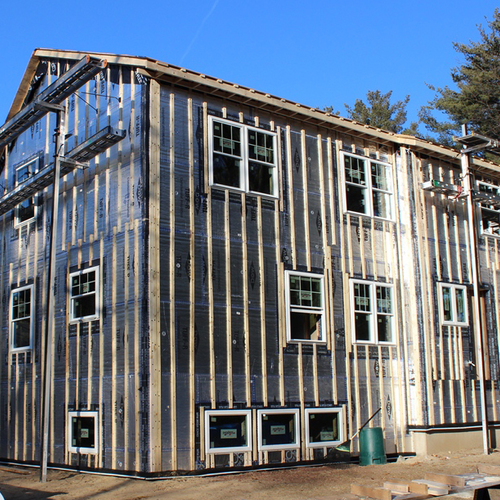
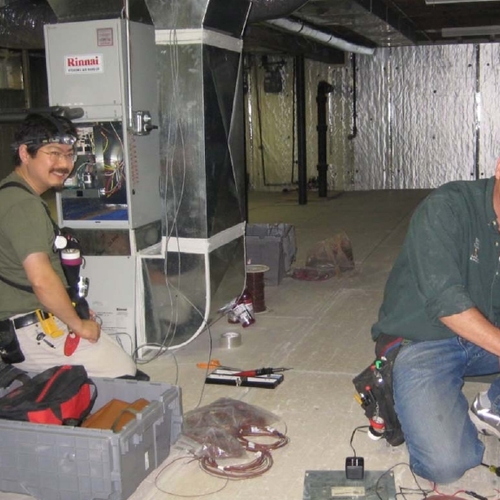

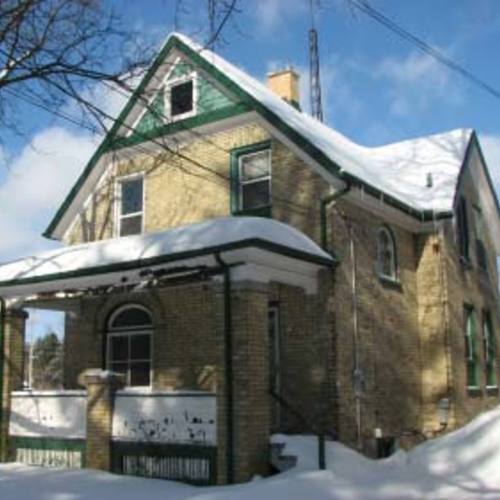






2 Comments
Great project - thanks for the coverage, Scott.
Interesting. But am I missing something? The panels have up to 8" of insulation so they're presumably at least about that thick. And they're being attached to existing walls that must also be about 8" thick. So the windows are 16" out from the room they're in?
Log in or create an account to post a comment.
Sign up Log in